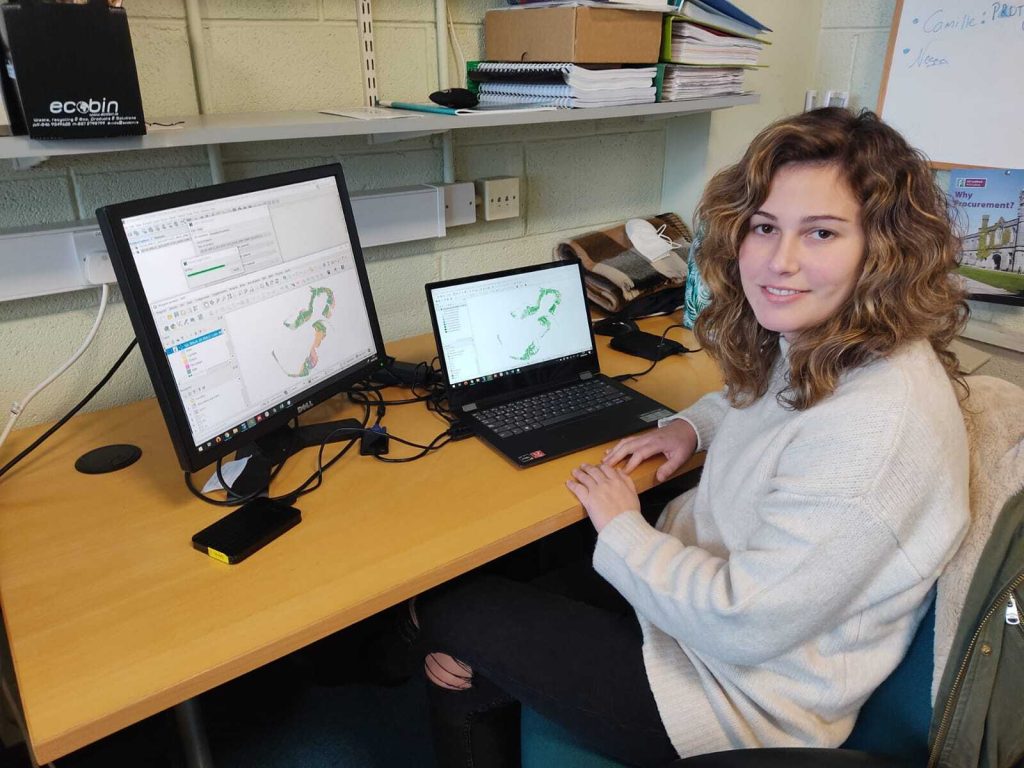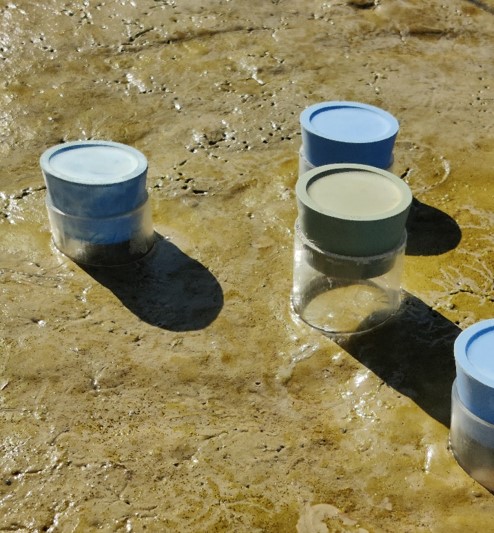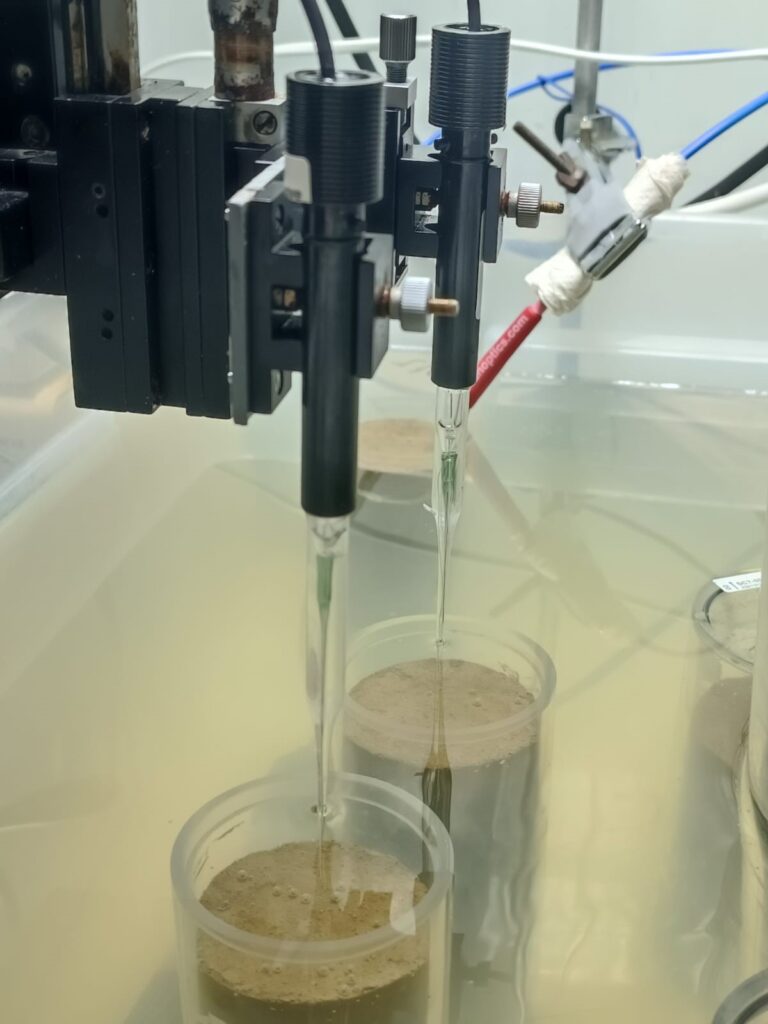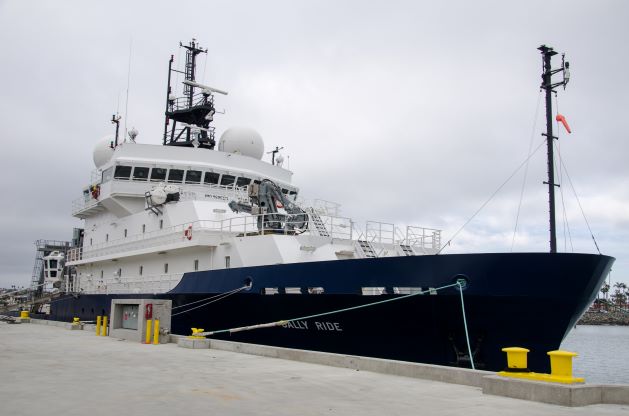Home » Uncategorized
Category Archives: Uncategorized
MEBL at the BlueZoneForum-Innovazul congress
On November 20, 21 and 22, the third edition of Innovazul will be held at the Congress Palace in Cádiz. This edition is organized in collaboration with the Zona Franca of Cadiz integrating two types of events in one: BlueZoneForum_INNOVAZUL 2024.
Our lab is there presenting a stand of our work related to the project Lab Bahia (PCM0030). We will also be presenting instrumentation, some of which we have developed ourselves, that is used in this and other closely related projects.
Looking forward to all the talks and interactions.
Sandra’s stay at SDU
After five months in Odense (Denmark), I have completed my stay at the University of Southern Denmark (SDU), where, in addition to learning how Aquatic Eddy Covariance (AEC) works, I conducted two experiments that provide key information on its application in intertidal zones. Although AEC is an innovative method for measuring O2 fluxes and studying various dynamics in aquatic ecosystems, its use remains limited due to its complexity. Internationally, only a few laboratories have adopted this technique, and in Spain, only one research institution has implemented it to date.

Aquatic Eddy covariance. A bit of an introduction….
The AEC is a non-invasive method that allows the measurement of benthic biogeochemical fluxes with a high resolution, during days or weeks continuously. This method is a relatively new technique (Berg et al., 2003). Over the last two decades, the quality of benthic O2 flux measurements by AEC has improved by incorporating new rapid response systems that measure O2. Due to their complexity, O2 measurement systems used for AEC must undergo rigorous testing under well-defined laboratory and field conditions to assess performance, reliability and potential limitations (Berg et al., 2016; Chipman et al., 2012; McGinnis et al., 2011).
An example of a new O2 measurement system is the AquapHOx-LX logger (PyroScience, GmbH; referred to as AquapHOx). It is an optical submersible meter, which has been designed to perform high resolution O2 measurements underwater, making it a suitable option for collecting robust AEC data.

In intertidal zones, the use of the AquapHOx system can present challenges due to temperature variations between the sediment and the water column. This can occur because, during low tide, the sediment is directly exposed to solar radiation, which causes significant heating of the sediment surface. When the tide rises and the sediment returns underwater, the temperature difference can generate heat fluxes from the seabed to the water column. These thermal fluctuations, however small, can affect the O2 signal. This potential error in the O₂ signal can alter the interpretation of biogeochemical fluxes in these areas.

Since AEC is a relatively new technique (Berg et al., 2003), there are hardly any studies in intertidal zones (Volaric et al., 2020) that quantify the importance of heat fluxes between the sediment and the water column. Therefore, it is necessary to test:
- how much the O2 signal is affected by temperature, i.e., what percentage of the oxygen fluctuations are driven by natural oxygen changes versus temperature effects, and
- how long it takes for the sediment surface and water to equilibrate in temperature.
To verify this, we performed two short experiments. The first consisted of quantifying the effect of temperature on the O2 signal; the second consisted in quantifying the time it takes for the sediment surface temperature to equilibrate with the water column.
Test 1. Evaluating the response of the O2 signal to temperature changes.
The sensitivity of the O₂ sensor to thermal variations was evaluated following the procedure described by Granville et al. (2023).
Test 2. Quantifying the time, it takes for the sediment surface temperature to equilibrate with the water column after the sediment surface was exposed to high temperature
This experiment aimed to measure how long sediment takes to reach equilibrium with the water column after being exposed to high temperatures, simulating low tide conditions. Additionally, it also examined whether sediment color affects heat absorption.
To do that, five sediment cores of different color were collected from Odense Fjord, Denmark, acclimatized for a day. After that, we performed different temperature profiles, with and without a water column, to obtain initial conditions.
The sediment surfaces were then exposed to high light intensity (simulating solar radiation) for 2 hours without water. Afterward, temperature profiles were measured every 20 minutes using a temperature probe until the temperatures returned to initial levels. The process was then repeated for each core in the presence of a water column.
After these experiment, we can conclude that, although, the sediment surface may heat up more in the absence of the water column and in darker sediments, the recovery time showed no observable differences. Furthermore, considering that the temperature of the water column and of the uppermost layers of the sediment quickly returned to their initial conditions, it can be concluded that AquapHOx can be used in intertidal zones.
The effect of an invasive algae on the beach biogeochemistry
We have successfully completed the second year of field samplings of the project “Beach biodiversity and the ecological role of the invasive species Rugulopteryx okamurae in beach ecosystem functioning” Project Excel_01050, lead by Ivan Franco Rodíl.
During the second year, we contributed in measuring the bacterial diversity and leaching of dissolved organic carbon associated with accumulation of the invasive algae on different beaches of the coast of Cádiz.
The samples are currently being analysed but they show already how the organic matter of the beach racks alters the microbial benthic community along the beach transect. Hopefully the results will contribute to the management of this environmental issue that affects the local economy (fisheries, tourism).
Effects of heatwaves on the physiology of benthic microalgae
Andalusia has a high diversity of wetlands. These include intertidal shallow systems, which are important both ecologically and economically, given that the microalgae that grow at the sediment surface are an important source of food for higher-level organisms such as fish, oysters etc.

The microphytobenthos (MPB) is the photosynthetic community living on the sediment surface. They play an important role in shallow estuaries as they can be responsible for a large part of the primary production. This community is dominated by diatoms (algae covered in a silicate casing, called the frustule) and can achieve very high densities giving a golden colour at the sediment surface.
In order to deal with the highly fluctuating environments conditions that characterize the intertidal areas, such as light, temperature, tide cycle and seasonal variations, diatoms have developed several strategies. For example, they have the capacity to migrate vertically during the day to adapt to the light conditions and tidal variation.
Marika Mecca, one of our PhD students, is trying to understand the effects of climate change on the physiology and behavior of these benthic microalgae. Under normal conditions, the sediment surface undergoes large changes in temperature between night and day, under water (immersion) or exposed to the air (emersion), and between seasons. Thus, under a climate change scenario where heatwaves are more frequent, the shifts in temperature will be even larger and the effects on the physiology of the microalgae can be detrimental.
To study these effects, Marika uses various instruments and sensors in the lab, such as oxygen microsensors to measure the amount of oxygen produced, temperature sensors to measure the variations vertically, reflectance sensors to detect the migration rhythms etc.
The principal area of study is the Guadalquivir River. Once the cores are collected in the field, back at the laboratory these sediments are subjected to different conditions simulating the changes observed in the field under normal and extreme weather conditions.
The results show an effect of prolonged high temperatures on the migration rhythm of the microalgae (avoidance of the sediment surface), although differences in total net metabolism are less probably due to a stimulation of rates by the higher temperature. These results were presented at the ASLO 2023 conference in Mallorca.
Sandra’s research stay in SDU
From 1 May until 1 October 2024, Sandra Rizzo, one of the pre-doctoral students from our laboratory, is visiting the University of Southern Denmark (SDU, Odense) on an international stay to learn the use of the novel Aquatic Eddy covariance (AEC) technique. Sandra will work under the supervision of Profs. Karl Attard and Ronnie Glud.
AEC is a direct and non-invasive method that allows the quantification of benthic metabolism rates by measuring oxygen fluxes with a high resolution, during days or weeks and continuously.

The stay at SDU will allow us to transfer the know how to our laboratory, which only a few laboratories at international level have and extend our collaboration with our Danish colleagues. Furthermore, in practical terms, the use of the AEC method will facilitate the monitoring of benthic metabolism rates in different habitats in our area and to study the effect of extreme wind events, without the logistical problems associated with sampling under such conditions. Our new project MULTIFLUX will focus heavily on this aspect.
Oxygen measurements in the lab
Oxygen measurement
Oxygen is the most advantageous electron acceptor during the process of respiration. That is why all higher organisms use oxygen to breathe. The oxygen is also involved in the re-oxidation of most reduced compounds produced by other types of anaerobic respirations (e.g. H2S, Fe2+, Mn2+). In addition, during daytime, photosynthesis by benthic microalgae produces oxygen Therefore, by quantifying oxygen consumption rates, we can have a net measure of both aerobic and anaerobic respiration processes, and of photosynthesis during light, occurring in the sediment.
How do we measure it?
In our laboratory, we usually use two different type of techniques, one using microsensors to measure vertical profiles of oxygen across the sediment water interface and with depth in the sediment and another by measuring the changes in oxygen concentrations in closed core incubations over time.
These methods provide similar but complementary information.
Microsensors
Profiles made with microsensors provide important information as to the total flux of oxygen across the sediment water interface, but also to the deeper layers, the depth of maximum oxygen production in light corresponding to the layer of microalgae, and the depth of the oxic zone (when oxygen concentration goes to zero). However, given that this method is based on a microsensor, fluxes measured are solely diffusive (movements of oxygen at a microscale) and are very localized to a small area around the tip of the sensor (a few microns).

Whole core incubations
Whole core incubations and measurements of the oxygen changes, provides a more integrated estimation of the oxygen flux as it includes a larger area, the consumption due not only of the microorganisms but also of larger macroorganisms (worms, molluscs, crustaceans etc). It also allows to include the effect of another process, that of advection that moves the oxygen molecules at larger spatial scales (for example by waves, the ventilation of burrows etc). This is why, fluxes measured by whole core incubation are called sometimes total fluxes.
To do this, we close the core (cylinder) containing our sediment ecosystem. On the inside of the lid there is a gel that contains a special dye that reacts with oxygen. Using an optical fibre we can measure through the transparent lid the changes in the fluorescence of the compound as the oxygen concentration changes inside the core. Quite cool..

However, both of them allow us to study the sediment metabolism and depending on the specific aims of our experiment, we use one or the other, or both. The more tools, the better!
RICAS: Postdoc offer to study the CO2 fluxes in intertidal ecosystems with the Eddy Covariance technique
We offer of postdoctoral contract for 1 year, extendable until 30/11/2024, to apply Atmospheric Eddy Covariance techniques in marshes and intertidal zones in the project “Rewilding saltmarshes to increase carbon sequestration, biodiversity and coastal adaptation to climate change as a nature based solution” (RICAS). RICAS is a project funded by the Recovery, Transformation and Resilience Plan of the Spanish Ministry of Science and Innovation.
What?
We are looking for a postdoctoral researcher with proven experience in the Eddy Covariance technique to study CO2 fluxes in the intertidal biological communities of Bay of Cadiz saltmarshes. The candidate will be responsible for setting up a new eddy covariance tower (ECV) with the aim of quantifying CO2 fluxes and evaluating the potential of saltmarsh rewilding, as a nature-based solution to mitigate the increase in atmospheric CO2 and climate change. The information obtained with the ECV will be compared with other techniques such as microsensors and incubations of benthic chambers in situ and sediment cores in the laboratory, in which our laboratory has great experience. The information obtained will be scaled up to the entire Bay using hyperspectral images obtained by drones and multispectral images by satellites, by researchers collaborating in the project
When?
The candidate should start as soon as possible (earliest expected date is late September, which depends on the selection process).
Where?
The selected candidate will join the Microbial Ecology and Biogeochemistry Group of the Department of Biology of the University of Cadiz, under the supervision of Alfonso Corzo and Sokratis Papaspyrou.
Requirements
– The candidate must have demonstrable experience (scientific articles, courses, etc.) in the atmospheric Eddy Covariance technique preferably in wetlands and marshes.
– Experience in other techniques related to Microbial Ecology and Biogeochemistry in wetlands and marshes will be highly valued.
– Must have good knowledge of written and spoken English (scientific level).
How to apply?
The University of Cádiz has opened the call for applications from June 20th to June 30th, 2023 on the website
https://personal.uca.es/convocatorias-de-capitulo-vi-2023/
Call documents: Appendix Calls June 2023 pdf
If you require more info or help to apply, please send an email to alfonso.corzo@uca.es, sokratis.papaspyrou@uca.es.
Sara in Ireland

Sara Haro, our former PhD student, has joined the Earth and Ocean Sciences research group at the School of Natural Sciences and Ryan Institute, National University of Ireland in Galway (NUIG) as a postdoctoral researcher, where she will monitor macroalgae blooms using machine learning algorithms from Sentinel-2 and Landsat-8 satellite images. This project is funded by the Ramón Areces Foundation as Sara won one of the 16 postdoctoral fellowships awarded by the Ramón Areces Foundation for further studies abroad in life sciences during 2022. Thus, she will continue working on the work she did while in our laboratory on using Sentinel-2 and Random Forest classification to study the patterns in space and time of microphytobenthos.
EXTREME-FUN: laboratory technician job offer
PID2020-112488RB-I00/ AEI / 10.13039/501100011033 «R&D Projects» 2020 – Modalities «Research Challenges» and «Knowledge Generation» // PI: Sokratis Papaspyrou /Alfonso Corzo (226.000 €)
Laboratory technician job offer to work on the impacts of Extreme Climatic Events, such as heat-waves and wind storms, on shallow coastal areas, focusing on the impacts on the biological community and biogeochemical functioning of shallow bays and intertidal zones.
What?
We are looking for a motivated candidate to work in microbial ecology and biogeochemistry of oceanic ecosystems. The job is offered within the EXTREME-FUN project (Effects of extreme climatic events on the biogeochemical functioning of shallow coastal areas: from the micro to the macroscale), which aims to quantify in an integrated manner the effect of heat waves and windstorms, affecting temperature and sediment resuspension conditions, on the biogeochemical functioning of a shallow coastal ecosystem.
The candidate, apart form the everyday laboratory activities, will support a combination of laboratory experiments, field measurements and aerial data (satellite, drones…) to study the spatial and temporal variability of the microphytobenthos and its contribution to the primary production of the system and evaluate the effect of changes in external forcing by temperature and resuspension/hydrodynamics under normal and extreme conditions on microphytobenthos physiology, benthic pelagic coupling and carbon flux throughout the system.
When?
The job start in February 2022 and will last initially 6 months, extendable up to a maximum of the duration of the project, reviewed annually.
Where?
The work will be carried out in the Microbial Ecology and Biogeochemistry Group of the Department of Biology of the University of Cadiz, under the supervision of Sokratis Papaspyrou and Alfonso Corzo.
Requirements
- The candidate must have obtained a bachelor’s degree on Marine or Environmental Sciences, Biology or similar .
- Be highly motivated and committed to work both in the laboratory and the field within a highly interdisciplinary and international project team.
- Have experience on biogeochemistry, aquatic microbial ecology, remote sensing, environmental chemistry or similar.
- Have a high level of written and spoken English.
For more details you can consult the call.
How to apply?
The call for applications is open from December 17 to December 28, 2021 on the website: Convocatorias de Capítulo VI 2021
Call: Annex 2
Applications
- Project Reference: PID2020-112488RB-I00, “EFECTO DE LOS EVENTOS CLIMATICOS EXTREMOS SOBRE EL FUNCIONAMIENTO BIOGEOQUIMICO DE ZONAS SOMERAS COSTERAS: DE LA MICRO A LA MACROESCALA”
- Job post reference: 12/2021/2
- Persons with a digital certificate (issued by an official public organisation) can send the application electronically through the following application: https://oficinavirtual.uca.es/oficinaVirtual/EntradaOficinaVirtual?procedimiento=110
- Persons without a valid digital signature certificate should consult the procedure here.
Please send an email with your CV to sokratis.papaspyrou@uca.es before applying for the position.










































